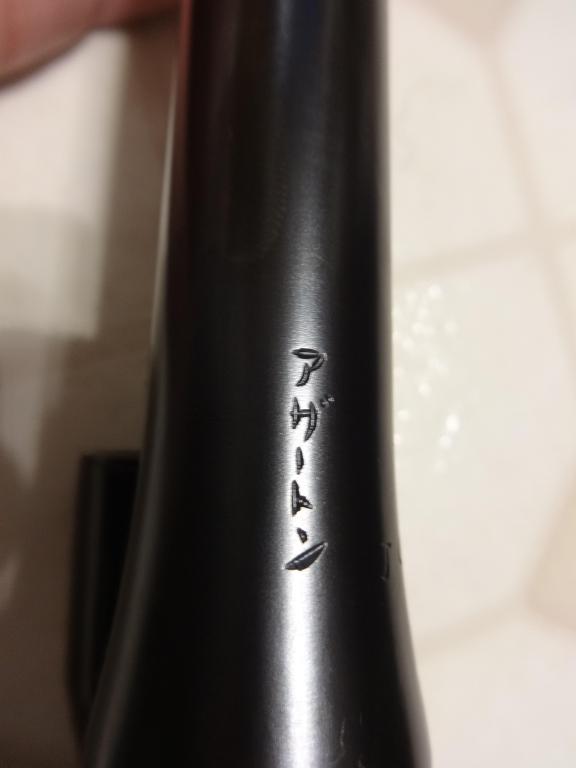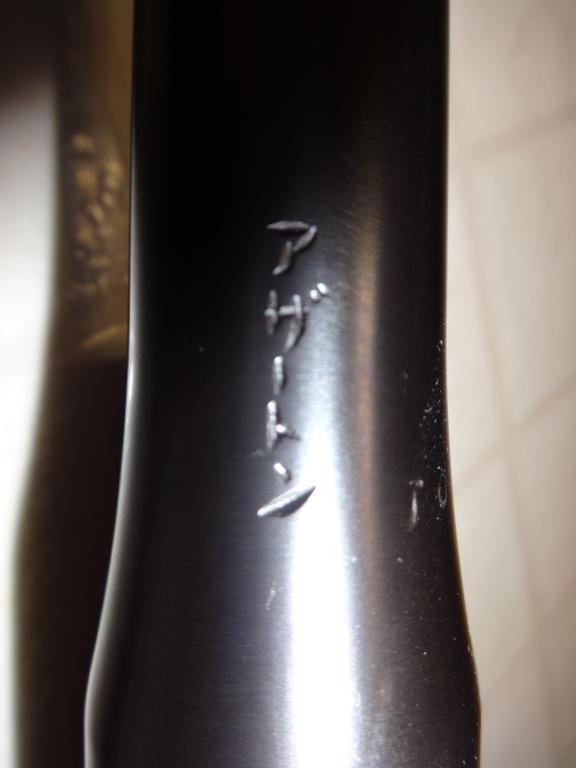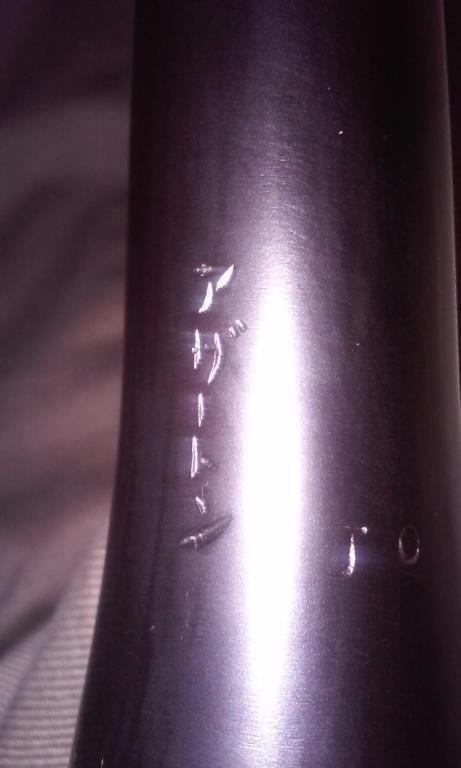-
FREE MEMBER
NO Posting or PM's Allowed

 Mystery markings on my M1917
Mystery markings on my M1917
Hello. I registered on this forum specifically for this mystery rifle, although I do hope to post on here more often, especially if I manage to collect even more milsurp firearms. I ordered this rifle, sporterized (I know, that bothers a lot of people) online a while back, and have been wondering about the kanji on the barrel ever since. The marking near the front sight is 12-18, so that appears to be WW1 original. I couldn't get a good picture of it, it was too shallow.
The interesting thing though is the strange markings on the underside of the barrel, accompanied by what looks like "J O"



I oriented the pictures in the way in which I have assumed, and been told by others, that they would probably be read. Does anybody have any idea what that means, or its origin? I really appreciate you taking a look.
http://imgur.com/a/9HgoF
http://imgur.com/a/zyMOj
I also included the full album of images of the markings I took, and general views of the rifle, if anybody is interested. It is really very beautiful. It looks like someone put a lot of time into sporterizing it.
Information
 |
Warning: This is a relatively older thread
This discussion is older than 360 days. Some information contained in it may no longer be current. |
|
-
07-19-2017 10:28 PM
# ADS
Friends and Sponsors

-
FREE MEMBER
NO Posting or PM's Allowed

-
-
Advisory Panel


The Japanese captured a vast number of 1917's when they occupied the Philippines. Possibly yours was one of those? It will be interesting when someone gives us a translation. You might post this on the Japanese forum as well as I am sure they can get a translation.
captured a vast number of 1917's when they occupied the Philippines. Possibly yours was one of those? It will be interesting when someone gives us a translation. You might post this on the Japanese forum as well as I am sure they can get a translation.
-
-
Legacy Member

There were also a good number of "17s sent to China and other friendly Asian countries before and during the war. This may be one of them.
-
-
FREE MEMBER
NO Posting or PM's Allowed

Thank you for the replies. I am aware of the capture of some of these in the Philippines and did seriously wonder if the kanji were Japanese in origin. I would definitely post this in the Japanese rifles section, or anywhere else that might be more appropriate, if I were certain that the markings were Japanese. I was also, remotely, aware of their use by the Chinese.
in origin. I would definitely post this in the Japanese rifles section, or anywhere else that might be more appropriate, if I were certain that the markings were Japanese. I was also, remotely, aware of their use by the Chinese.
I have spoken (prior to posting this thread) with one person directly who is quite good with Japanese, and have indirectly contacted another. The first didn't exactly recognize all of the characters, or the English translation of the their literal romanization. The second, going off of my old, blurry/hazy picture thought they recognized アザートン, romanized as azaaton, which apparently translates to Atherton. There was a U.S. destroyer escort during WWII named the U.S.S. Atherton, which did operate in the pacific theater near the end of the war and today, ironically, is in service in the Philippine navy, having previously belonged to the Japanese following WWII.
destroyer escort during WWII named the U.S.S. Atherton, which did operate in the pacific theater near the end of the war and today, ironically, is in service in the Philippine navy, having previously belonged to the Japanese following WWII.
I'm no expert, but the kanji don't seem to me to match those that were romanized as azaaton, no doubt because of the poor image quality. This may well all be possible, but it seems to be quite a stretch to me that the name of a U.S. destroyer escort is engraved in Japanese on a rear-echelon, infantry rifle, especially since this destroyer doesn't seem to have ever been captured by the Japanese during the war, unless the Japanese retained and fielded some full-length M1917 rifles after the war on naval vessels? It appears that that vessel was acquired by the Japanese in 1955. Additionally, the Japanese obviously renamed her while in their service.
I was mostly hoping for something similar to this having been seen before, because Google searches for anything similar have yielded nothing, although I don't yet know for sure what I'm looking for either.
Last edited by xb0xisbetter; 07-20-2017 at 11:18 AM.
-
Advisory Panel


i have seen a few of the Aisian owned 17s, what i found best,
is to have an actual Japanese person that can read it, tell you what it is.
person that can read it, tell you what it is.
like alot of things, info on the net can be wrong.
i have a couple friends on FB that live in Japan, one is a historian, and has helped me a few times with such markings
-
-
Advisory Panel


Why are the marks where they are?
I can't offer a solution, but I think that before diving into interpretation it would be helpful to consider WHY the markings are placed where they are? Any kind of rack number, ownership marks or other such public statements ("This is OUR rifle") would surely be placed where everyone can see them?
Marks on the bottom of the barrel or - and this is really extraordinary - on the inside of the floorplate, where no-one can see them without dismanting the rifle, are therefore hardly ownership marks but something to do with parts/assembly identification.
And just to muddy the waters even further, I would be cautious of assuming that they are Kanjis of any kind. In fact, to my eyes they look more like Naga (North-East India) characters!
Or how about reading them from top to bottom - I see PHIL... in a kind of runic script...
Last edited by Patrick Chadwick; 07-23-2017 at 04:28 PM.
-
-
Legacy Member


Originally Posted by
xb0xisbetter

Thank you for the replies. I am aware of the capture of some of these in the Philippines and did seriously wonder if the kanji were Japanese in origin. I would definitely post this in the Japanese rifles section, or anywhere else that might be more appropriate, if I were certain that the markings were Japanese. I was also, remotely, aware of their use by the Chinese.
I have spoken (prior to posting this thread) with one person directly who is quite good with Japanese, and have indirectly contacted another. The first didn't exactly recognize all of the characters, or the English translation of the their literal romanization. The second, going off of my old, blurry/hazy picture thought they recognized アザートン, romanized as azaaton, which apparently translates to Atherton. There was a
U.S.
destroyer escort during WWII named the U.S.S. Atherton, which did operate in the pacific theater near the end of the war and today, ironically, is in service in the Philippine navy, having previously belonged to the Japanese following WWII.
I'm no expert, but the kanji don't seem to me to match those that were romanized as azaaton, no doubt because of the poor image quality. This may well all be possible, but it seems to be quite a stretch to me that the name of a U.S. destroyer escort is engraved in Japanese on a rear-echelon, infantry rifle, especially since this destroyer doesn't seem to have ever been captured by the Japanese during the war, unless the Japanese retained and fielded some full-length M1917 rifles after the war on naval vessels? It appears that that vessel was acquired by the Japanese in 1955. Additionally, the Japanese obviously renamed her while in their service.
They aren't Kanjis, but Katagana.
In regards to Japanese service weapons post-WWII, I believe there were a lot of American arms (with the whole occupation of Japan). Look at how they converted some Arisaka Type 99s to .30-06 when Korea was going on as that was the new common caliber. Your also very unlikely to find much information about it, as Japan post-WWII isn't a popular research topic for firearms.
Type 99s to .30-06 when Korea was going on as that was the new common caliber. Your also very unlikely to find much information about it, as Japan post-WWII isn't a popular research topic for firearms.
A destroyer would also be a more likely place to find a M1917, especially if you were sending it to a ally who you wanted to have similar gear but not the best standard. Retained and fielded M1917s post-WWII not be the best way to put it, rather likely received M1917s as post-war armaments from the Americans would be a good possibility.
-
-
FREE MEMBER
NO Posting or PM's Allowed

I wish I did know an actual Japanese person. Unfortunately, I do not.
person. Unfortunately, I do not.
I had been thinking about the same thing, Patrick Chadwick. why the underside of the barrel and inside the magazine floorplate to begin with? If you look at the entire album, it even looks like the magazine floorplate is Winchester-made, while the Receiver (and probably barrel) are Remington, yet they have identical characters, seems odd that they would bother matching up the magazine floorplate to a receiver that's already mismatched. Reading from top to bottom had been guessed by me, and further suggested by those who know Japanese kanji/katagana/etc, before I started this thread.
All of my responses on this specific thread were made before you identified the characters as Katagana and not Kanji, in the Japanese thread. I honestly do not know the first thing about traditional Japanese characters, and assumed that all were called Kanji. Do we really know for sure that Japan was using .30-06 Arisakas? The only thing I can turn up about Arisakas being converted to .30-06 was for use in Thailand, and absolutely nothing about Japan using the M1917 at all outside of captured rifles used by Japanese police when they took the Philippines. A U.S. coastguard vessel was sent to Greenland, which dropped off 50 M1917 rifles for its inhabitants to use to defend against the Germans once Denmark fell against the Third Reich during WWII. For some reason we have plenty of information about these 50 rifles, and how they were put to use, but absolutely nothing at all about post-war use of the M1917 by the Japanese, as these Katagana may suggest. Maybe, assuming that this is the case, the Japanese have records of this having taken place, which have simply not been translated into English and/or are hidden away in some dusty filing cabinet somewhere in Japan. In that case, you would think there would be an appreciable number of similar rifles as well, and I can't seem to find a trace of any others like this one yet.
fell against the Third Reich during WWII. For some reason we have plenty of information about these 50 rifles, and how they were put to use, but absolutely nothing at all about post-war use of the M1917 by the Japanese, as these Katagana may suggest. Maybe, assuming that this is the case, the Japanese have records of this having taken place, which have simply not been translated into English and/or are hidden away in some dusty filing cabinet somewhere in Japan. In that case, you would think there would be an appreciable number of similar rifles as well, and I can't seem to find a trace of any others like this one yet.
I have, thus far, been told by two different people, including Eaglelord17's acquaintance , that the Katagana translate to Atherton, but assuming that this is 100% accurate, the question of why the Japanese would engrave the name of a U.S. navy vessel into its rifles when the vessel will not even be called this while in service with the Japanese navy. I do believe that you're 100% spot-on about it being Katagana, as I found literally every single character other than the vertical line in the center in a Katagana alphabet table.
The more questions that are answered, the more pop up with this thing. I'm beginning to think this is going to remain a mystery unless someone who just so happened to be a former Japanese Navy armorer aboard a former U.S. Navy ship, somehow happens to see this and recognize it, which still assumes that this is actually related to why these Katagana were engraved on the rifle/s.
-
Advisory Panel


Not Atherton
OK, so let's go with Katakana characters. Katakanas are syllabic characters, i.e. consonant plus vowel combinations. And assume that ALL marks are deliberate, not accidental!
Take the first photo in the original post, and read it top to bottom.
First character is an A with no preceding consonant.
Second character looks like a Ta, but the small marks above and to the right are not accidental, but diacritical signs, in this case dakuten or voicing marks. So the Ta is to be pronounced as Da.
Third character has me stumped, unless it is just a hyphen (remembering that katakana is used for transliterating words in Western characters). It is more likely to be the symbol for a long vowel, written vertically, thus makiing the Da into a Daa.
Fourth is a clear To.
Fifth is not N - the small stroke top left is part of the character. It is So.
We now have:
ADaaToSo.
And as to what that means - your guess is as good as mine!
I repeat - these are marks that can only be read if the rifle is dismantled. That must be a clue.
Last edited by Patrick Chadwick; 07-24-2017 at 08:04 AM.
-


















 Register To Reply
Register To Reply














